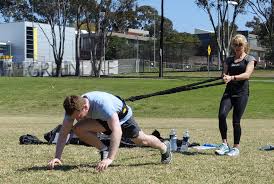The Importance of Agility Training
By Natalie V.
My athletic career began at the young age of four. I was not the tallest player on the field, nor was I the strongest, but I did have one attribute that made me stand out, and that was my speed.
Reflecting back on my time as a student athlete, I now realize the opportunities that I received back then because of my speed. I grew up playing soccer and softball. In high school, however, I played softball and volleyball. My speed helped me stand out during freshman year at tryouts, and it helped me to earn spots on both varsity rosters.
I further developed my natural speed with agility training, weight lifting, and various conditioning drills. When I attended Menlo College in California, I continued with my softball career at the university level.
I can honestly say that I would not have made it to that level if it weren’t for my speed. This helped me realize the importance of speed in athletics. Speed is one of the main fitness components that is crucial for success in many sports. When combined with flexibility, strength, and sport-specific exercises, speed creates an elite athlete.
Whether training for strength, endurance– or a combination of both– the benefit of adding speed, agility, and quickness drills to a fitness routine can take your game to the next level.
All athletes can benefit from improved balance, quicker feet, and a faster reaction time. Oftentimes, athletes simply train solely at practice, and maybe, add in weight lifting for added strength. Success in sports, however, relies on an athlete’s ability to move fast and change direction quickly, which is why training for agility and quickness should be the ultimate goal for an athlete’s training program.
Agility is defined as the ability to move quickly and easily, and it is what sets apart great athletes from the average. For example, Steph Curry is not the strongest basketball player, nor is he the tallest, but he moves quickly and fluidly, making it hard for his opponents to defend.
An athlete is constantly tested on his or her ability to accelerate in a target direction, as fast as they can, and then decelerate, plant, and reposition themselves to swiftly reaccelerate. By incorporating these skills regularly in practice, it becomes easier for athletes to perform them in game situations. If an athlete has strong coordination and speed, they are not only at a distinct advantage, but also less likely to be injured.
As important as it is for athletes to be training for their speed, agility, and quickness, one does not need to be a competitive athlete to receive the benefits of improved coordination and body awareness to partake in this type of training. Agility training is both challenging and engaging, which tends to make the workout more fun! This type of training is also known for using more than one muscle at a time, causing one to burn more calories during one’s workouts. Whether you are an all-star football player, a stay-at-home mom, a weekend warrior, or just starting your fitness journey, agility training should be an important part of everyone’s workout routine.
Natalie grew up in Prospect, CT where she started playing sports at the young age of 4 and continued playing throughout her life, including paying softball and volleyball for both travel and high school teams. At Menlo College in California, she continued with her love of sports by playing softball at the university level. Her passion for athletics inspired her to pursue a career in sports performance and Exercise Science, completely changing her career path from her original Sports Broadcasting major. She realized she was no longer interested in reporting about athletics, but rather, she wanted to be hands-on, helping others. Natalie’s ultimate goal is to inspire others to develop a passion for health and fitness, and to assist them in reaching their goals as their best self. She has specifically developed a profound interest in agility training and assisting athletes become more explosive. Natalie is a W.I.T.-certified personal trainer. She is also a student at Central Connecticut State University, and is scheduled to graduate with a degree in Exercise Science, and a minor in Mass Media Communications. Furthermore, Natalie plans to continue her education to become a yoga instructor, so that she can also aid in the recovery of athletics.






